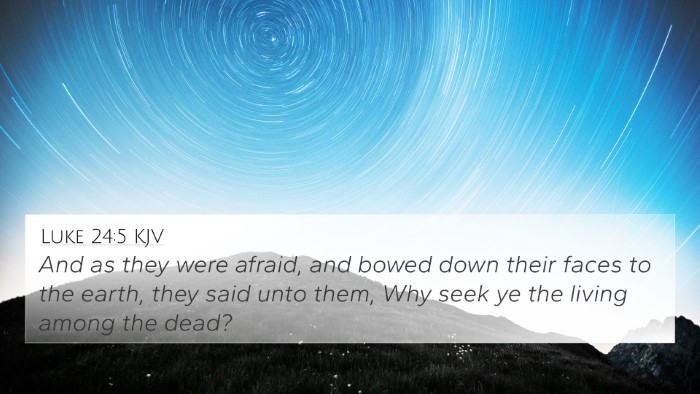Understanding Matthew 17:7
Matthew 17:7 states: "But Jesus came and touched them, and said, 'Arise, and be not afraid.'" This verse provides a profound insight into Jesus' character and His interaction with His disciples during a crucial moment of fear and confusion.
Contextual Background
This verse occurs during the incident known as the Transfiguration, where Jesus had revealed His divine glory to Peter, James, and John. Following this awe-inspiring event, the disciples were terrified, which is a natural human response to witnessing such a divine manifestation.
Interpretation and Meaning
The touching of the disciples by Jesus symbolizes His care and compassion. The reassurance to "Arise, and be not afraid" is significant, showing His desire to alleviate their fear and encourage them to stand strong in their faith.
Insights from Public Domain Commentaries
- Matthew Henry: Henry emphasizes the tenderness of Jesus in this scene, noting that His physical touch represents a familial comfort. It reminds us that amid our fears, Jesus invites us to rise above our anxiety with His presence.
- Albert Barnes: Barnes points out the importance of Jesus’ words to not be afraid. This serves as a universal call to all believers, reflecting God’s promise of peace even in our troubling times. He connects this to the broader theme found throughout scripture of God reassuring His people.
- Adam Clarke: Clarke highlights the transformative power of Jesus’ touch, noting that it not only calmed the fears of the disciples but prepared them for their mission ahead, reinforcing that encounters with Christ should lead to action and courage.
Related Bible Verse Cross-References
This verse can be cross-referenced with several key passages that illustrate similar themes of divine reassurance and the call to courage:
- Isaiah 41:10: "Fear not, for I am with you; be not dismayed, for I am your God; I will strengthen you, I will help you." This reinforces God's constant presence in fearful situations.
- Matthew 14:27: "But immediately Jesus spoke to them, saying, 'Take heart; it is I. Do not be afraid.'" Here, Jesus again offers comfort in the midst of distress.
- Luke 8:50: "But Jesus on hearing this answered him, 'Do not fear; only believe, and she will be well.'" This illustrates the power of faith over fear.
- John 14:27: "Peace I leave with you; my peace I give to you. Not as the world gives do I give to you. Let not your hearts be troubled, neither let them be afraid." This highlights the peace that comes from trusting Jesus.
- Acts 18:9-10: "And the Lord said to Paul one night in a vision, 'Do not be afraid, but go on speaking and do not be silent, for I am with you...'" This reflects God's assurance to His followers.
- 2 Timothy 1:7: "For God gave us a spirit not of fear but of power and love and self-control." This underscores the idea that fear is not from God.
- Revelation 1:17: "When I saw him, I fell at his feet as though dead. But he laid his right hand on me, saying, 'Fear not, I am the first and the last.'" This shows how divine encounters transform fear into assurance.
Connecting Themes Across Scripture
The message communicated in Matthew 17:7 parallels multiple themes encountered throughout the Bible, focusing on the presence and power of God to dispel fear:
- Offering Comfort: In times of distress, God often speaks words of comfort (e.g., Psalm 23:4).
- Encouraging Faith: Biblical narratives frequently stress the importance of faith overcoming fear (e.g., Hebrews 11:1).
- God's Presence: The assurance of God's presence as a means to dispel fear is a recurring theme (e.g., Deuteronomy 31:6).
Conclusion
In conclusion, Matthew 17:7 serves as a poignant reminder of Jesus’ compassionate nature and His assurance to those who follow Him. Through careful analysis and cross-referencing with other Scripture, we can see that the fear experienced by the disciples is not uncommon. Jesus continually reaches out to his followers, encouraging them to rise and cast aside their fears.
Tools for Further Study
For those interested in deepening their understanding through cross-referencing and thematic analysis, several resources can aid in the process:
- Bible Concordance: Useful for finding specific verses related to key themes or words.
- Bible Cross-Reference Guide: A systematic approach to linking verses across scripture.
- Cross-reference Bible Study: Engaging in group studies that focus on themes across different books of the Bible.
- Comprehensive Bible Cross-Reference Materials: Various tools and software that aid in finding connections across books.
By utilizing these tools and approaches, believers can uncover the rich network of inter-Biblical dialogue that enhances their understanding of God's word and His messages of comfort and assurance.










